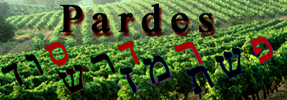PaRDeS, an acronym formed from the first letters of the four levels of Torah interpretation, means ‘orchard’ in Hebrew. (The English word Paradise (PaRaDiSe) is derived from the same Persian root).
![]() Peshat: the intended, explicit meaning.
Peshat: the intended, explicit meaning.
Within the p’shat you can find several types of language, including figurative, symbolic and allegorical. The following generic guidelines can be used to determine if a passage is figurative and therefore figurative even in its p’shat:
When an inanimate object is used to describe a living being, the statement is figurative. For example, Isaiah 5:7 – For the vineyard of the Lord of hosts is the house of Israel, and the men of Judah his pleasant plant; and he looked for judgment, but behold oppression; for righteousness, but behold a cry…
When life and action are attributed to an inanimate object the statement is figurative. For example, Zechariah 5:1-3 – Then I turned, and lifted up my eyes, and looked, and behold a flying scroll….
When an expression is out of character with the thing described, the statement is figurative. For example, Psalm 17:8 – Keep me as the apple of the eye, hide me under the shadow of your wings….
Remez in modern Hebrew means “hint”: the text may have another, deeper meaning.
There may still be a p’shat meaning, as any verse can have multiple levels of meaning. An example of implied remez from Proverbs 20:10: Different weights, and different measures, both of them are alike an abomination to the Lord. The p’shat would be concerned with a merchant using the same scale to weigh goods for all of his customers. The remez implies that this goes beyond this into aspects of fairness and honesty in anyone’s life.
 Derash: the interpretative meaning.
Derash: the interpretative meaning.
The drash is an interpretation that not explicit in the text. (The word midrash is from the same root.) This is a teaching or exposition or application of the p’shat and/or remez. (In some cases this could be considered comparable to a sermon.) For instance, Biblical writers may take two or more unrelated verses and combine them to create a verse(s) with a third meaning. There are three rules to consider when utilizing the d’rash interpretation of a text:
A drash understanding cannot be used to strip a passage of its p’shat meaning, nor may any such understanding contradict the p’shat meaning of any other scripture passage. As the Talmud states, “No passage loses its p’shat.”
Let scripture interpret scripture. Look for the scriptures themselves to define the components of an allegory.
The primary components of an allegory represent specific realities. We should limit ourselves to these primary components when understanding the text.
![]() Sod: the mystical or esoteric meaning.
Sod: the mystical or esoteric meaning.
Sud is the hidden, secret or mystic meaning of a text. An example most people are familiar with is Revelation 13:18, regarding the “beast” and the number “666.”

